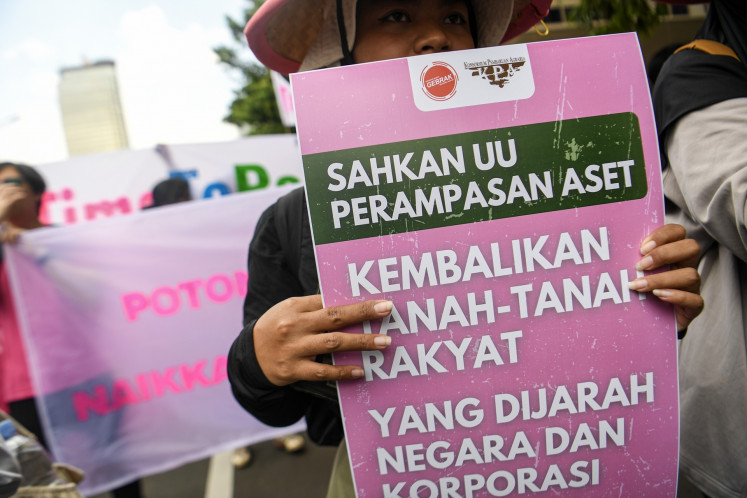Popular Reads
Top Results
Can't find what you're looking for?
View all search resultsPopular Reads
Top Results
Can't find what you're looking for?
View all search resultsThe future of PayLater after the COVID-19 pandemic in RI
Change text size
Gift Premium Articles
to Anyone
I
n the last two to three years online shopping has had a significant increase in transactions. The SEA e-Conomy report estimates the highest growth of e-commerce transactions is in Indonesia, which is projected at 22 percent and would reach US$59 billion this year.
As digital trade develops in ASEAN, various alternative payment methods have emerged. Digital payments are increasingly popular and are widely used, such as instant digital payments. The popularity of digital payment methods has accelerated since the pandemic first struck. These instant digital payments are e-wallets and pay-later options, popularly known as PayLater or Buy Now Pay Later (BNPL).
The rise of online shopping also contributes to the growth of instant digital payments, especially PayLater methods. Not only because of the COVID-19 pandemic, the growth of PayLater is also supported by the jump in internet users and the fact that credit card penetration is still considerably low in this country.
According to a survey of Indonesian e-commerce behavior by Kredivo and KataData, around 17 percent of consumers who conduct non-cash transactions use PayLater as their most frequently used payment method in 2022. PayLater became a payment option for online shopping because consumers could make purchases and pay for them at a later date without worrying about interest fees.
The ease of registration and requirements for the PayLater method makes it appealing to consumers. The process of paying for purchase transactions using PayLater in e-commerce is also very easy because this feature has been integrated into the checkout process. Consumers do not need to process payment by switching applications or filling in personal data.
Another advantage of PayLater is that there is no annual fee. For a longer credit option or higher transaction amount, PayLater can also act like a credit card, which provides a credit tenor of up to 12 months or up to 24 months for micro, small and medium enterprises (MSMEs).
The PayLater service offers zero interest rates and more agreeable approvals. The service can be accessed through a smartphone. In addition, PayLater is an option for those who do not have a credit card due to eligibility requirements. However, because the emergence of BNPL is relatively new compared with credit cards, the availability of services for BNPL is still limited.
Globally, compared with other payment methods, the market value of PayLater will continue to grow. Global Payment Report (GPR) reveals that BNPL had a market value of US$4.95 billion in 2021, and is expected to continue to grow to US$20.4 billion by 2028 with a compound annual growth rate (CAGR) of 22.4 percent.
Moreover, PayLater contributed 3 percent of the value of e-commerce transactions in 2021 and this figure is expected to grow to 5 percent in 2025. By that year, on the contrary, the share of credit cards is expected to continue declining.
For PayLater services to be more competitive in e-commerce transactions, it is not enough just to engage in partnerships. PayLater providers need to make more attractive offers in the future. Because e-commerce platforms view PayLater providers as strategic partners to develop a unified ecosystem in e-commerce that could benefit each other.
What kind of offer should PayLater providers prepare? Before creating a product or promo, BNPL providers must recognize the different types of borrowers. There are several types of borrowers in PayLater.
First, consumers use the service to manage their monthly expenses and cash flow. They will pay those expenses on each maturity date on a timely basis. Second, consumers who use PayLater because it facilitates payment and minimizes being subject to recurring fees if paying using other methods. By using PayLater, there are no transfer fees with the possibility of receiving discounts price and free shipping fees. The last is the type of consumers who have a limited budget but want to buy something quickly and easily.
As PayLater's user base grows, the nonperforming loan (NPL) risk from the service also increases. Rating firm Pefindo noted that the NPLs for PayLater were relatively high at the level of 6.49 percent as of July 2022. Total PayLater serviced loans reach Rp 3.1 trillion (US$197,862) from 78 million loan facilities and the number of debtors reached 9.44 million. PayLater NPLs beat those of other consumer financing products, such as credit cards and unsecured loans.
To reduce the risk of NPLs on PayLater providers, regulations must be created with special rules regarding the service. Regulations governing the filing process, handling complaints, disclosure obligations and minimum standards as well as BNPL providers checking consumers need to be considered in the future to ensure PayLater providers and consumers conduct safe transactions.
Even though the number of PayLater loans is small and trivial, it is still necessary to note that most PayLater consumers are those who are not served by banks.
Indonesia can see the British government's plans for the PayLater service to tighten rules on the BNPL sector to protect users. One of its objectives is to require PayLater providers to carry out a check on consumer eligibility to borrow before approval. Furthermore, the nature of PayLater is to provide a solution for short-term payments.
Defining the category in which the maximum installment duration and value of the transaction can be undertaken by the PayLater provider will be important. In doing so, regulators could manage the systemic risk that could come from that service while making sure PayLater payment methods coexist with other payment systems in Indonesia.
*****
The writer is an analyst at Mandiri Institute










